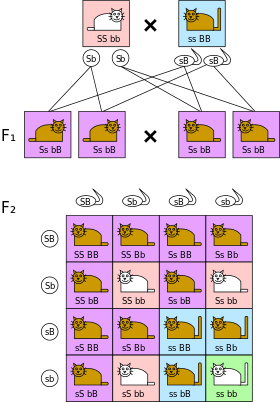Dihybrid cross

A dihybrid cross crosses F1 offspring (first-generation offspring) of two individuals that differ in two traits of particular interest. For example, BB × bb (see the Punnett square). Example: B = brown. b = blue. BB = Dark brown. Bb = Brown (not blue). bb = Blue.
A dihybrid cross is often used to test for dominant and recessive genes in two separate characteristics. Such a cross has a variety of uses in Mendelian genetics.
For example: RRyy/rrYY or RRYY/rryy parents result in F1 offspring that are heterozygous for both R and Y (RrYy).[1]
Meiosis (cell reduction) is the cellular process of gamete creation. It is where sperm and eggs get the unique set of genetic information that will be used in the development and growth of the offspring of the mating. The rules of meiosis, as they apply to the dihybrid, are codified in Mendel's first law and Mendel's second law, which are also called the Law of Segregation and the Law of Independent Assortment, respectively.
For genes on separate chromosomes, each allele pair shows independent segregation. If the first filial generation (F1 generation) produces four offspring, the second filial generation, which occurs by crossing the members of the first filial generation, shows a phenotypic (appearance) ratio of 9:3:3:1.
The dihybrid cross illustrates the law of independent assortment. The separation of gene pairs in a given pair of chromosomes and the distribution of the genes to gametes during meiosis is entirely independent of the distribution of other gene pairs in other pairs of chromosome.
Mendel's dihybrid cross
Scientist Gregor Johann Mendel crossed pure breeding peas with round seeds and yellow albumen to pure breeding plants with wrinkled seeds and green albumen. The F1 generation plants all had round seeds and yellow albumen and Mendel predicted that they would be heterozygous for both traits (RrYy).
References
External links
- "Dihybrid cross" - The Mosby Medical Encyclopedia
- "Dihybrid Cross - A Genetics Definition" - About:Biology